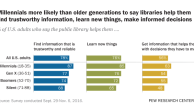In case you missed it, we just released our latest data on home broadband adoption among American adults:
- Some 70% of American adults ages 18 and older have broadband at home as of May 2013.1 Another 3% of adults go online at home via dial-up.
- One in ten adults (10%) lacks home broadband but does own a smartphone.
The report also found that demographic groups with the highest rates of home broadband adoption continue to be college graduates, adults under age 50, and adults living in households earning at least $50,000, as well as whites and adults living in urban or suburban areas. (More data on broadband adoption by different demographic groups is available in the full report.)
The Census Bureau’s July 2011 Current Population Survey found that about 98% of U.S. households live in areas where they have access to broadband Internet connections as of July 2011, although only 69% of households used broadband at home at that time.2 Our previous research has found that many dial-up users cite cost and access as the main reasons they don’t have broadband, though for adults who don’t use the internet at all, a lack of interest is often the main issue.
One in ten adults owns a smartphone but lacks home broadband
In recent years internet-connected mobile devices such as smartphones have exploded in popularity, offering an alternate form of “home” internet access (some 56% of American adults own a smartphone of some kind.)
Though smartphones have often been heralded as a way to “bridge the digital divide,” it’s unclear whether smartphones qualify as “broadband” speed, or whether they offer the same utility to users as a dedicated home internet connection.
However, smartphones do offer a potential source of online access to individuals who might otherwise lack the ability to go online at all from within the home, even if that access is somewhat limited in comparison. And indeed, our report also found that 10% of American adults own a smartphone, but lack a broadband connection at home.
Our data shows that while counting smartphones as a form of high-speed home internet access helps narrow the differences between some demographic groups, it actually widens the gap between others. For instance, the following chart shows that while blacks and Latinos are less likely to have access to home broadband than whites, factoring in their use of smartphones does nearly eliminates that “gap.”3 Yet including smartphones actually exacerbates differences in “broadband” adoption rates when we look at adoption by age group, due to the fact that younger adults are much more likely to own smartphones than older adults.

Rural broadband adoption and access
Our report finds that urban adults and suburban adults continue to be significantly more likely than adults living in rural areas to have home broadband. This gap persists even when smartphone ownership is factored in, as shown in the following chart.

Though our research focuses on adoption instead of physical access or connection speed, data on these issues and more is available in the report “Broadband Availability in Urban vs. Rural Areas” (pdf) from the National Telecommunications and Information Administration (NTIA).
Government data and resources
The Census Bureau has state-by-state data on home internet, computer, and smartphone use from its July 2011 survey, which is also used by the National Telecommunications and Information Administration (NTIA) in “Exploring the Digital Nation: America’s Emerging Online Experience.” The NTIA report includes data on types of broadband connections, internet and broadband costs, state-level data, and data for smaller demographic groups such as Asian Americans and American Indian and Alaska Natives.
The NTIA’s interactive National Broadband Map also has lots of data on topics such as types of broadband connections, connection speeds, number of broadband providers, or area demographics by state, county, metropolitan area, and more. For more, see ntia.doc.gov/data.



